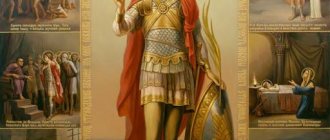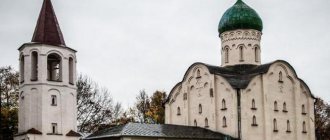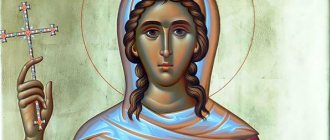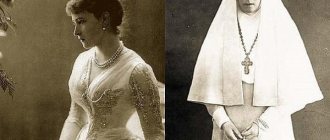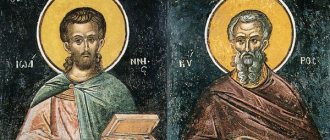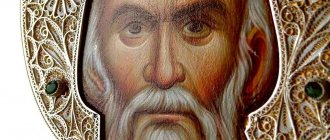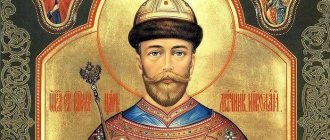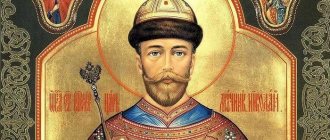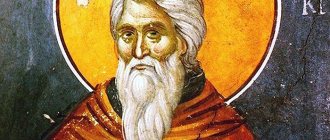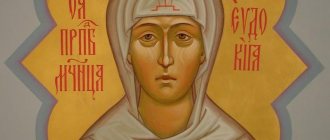Often in our lives there are situations when we are faced with an important choice, or doubts begin about some action. In such cases, we try to drive away such doubts from ourselves, or postpone the choice until tomorrow. But this is not recommended. Why didn’t anyone think about the fact that prayer to St. Helena Equal to the Apostles could help?
Helen Equal to the Apostles was the mother of the ruler of the Roman Empire. It gained fame in peasant circles due to the spread of the peasantry and the conduct of archaeological operations. At which, it was believed, the cross of the son of God was discovered. In memory of her and her wonderful deeds, many churches were built in the world.
Patron saints of those named Leonidas
Leonidas of Egypt, martyr
Order an icon
Remembrance Day was established by the Orthodox Church on June 5/18. All that is known about this saint is that he lived at the end of the 3rd century and suffered for Christ under the Emperor Maximian. Leonidas, martyr
Order an icon
Remembrance Day was established by the Orthodox Church on August 8/21. Leonid Ustnedumsky, hieromonk
Order an icon
Remembrance Day was established by the Orthodox Church on July 17/30. Saint Leonid lived in the 16th century in the Vologda region. At the age of 50, he had a wonderful dream in which he received the blessing of the Mother of God to build a temple in the name of the icon of Hodehydria on the Luza River. He had to take the icon for this temple in the Nikolaevskaya Morzhevskaya Hermitage on the Dvina River. But Leonid did not dare to do this. He went to the Novgorod Kozeozersky Monastery and became a monk. However, the dream was repeated again and again, and Leonid went to carry out his assignment. Having received the icon from the rector of the Nikolaev Hermitage, he built a cell and a chapel in the indicated place near Turin Mountain, and after receiving the blessing of the Metropolitan of Rostov and being ordained a hieromonk, Leonid erected a wooden church in honor of the Entry into the Temple of the Mother of God, where he placed the icon of Hodehydria. During the establishment of the monastery, the following incident happened to him. In order to facilitate passage to the church through the forest swamps, Saint Leonidas began to dig a canal from the Luza River to the Black Lake, and at that time he was bitten by a snake. Deciding not to think about the consequences, trusting in God’s mercy, the ascetic remained healthy and, in gratitude to the Lord, named the canal the Nedumaya River, and his monastery the Ustnedumskaya. The monk spent a lot of energy fighting the harsh nature. During floods, the Luza River flooded the church. And the tireless worker, despite his advanced age, moved her to a higher place near the Black Lake. The temple was consecrated by Archimandrite Arseny of the Arkhangelsk Monastery, and subsequently the Ustnedumsk monastery attracted many Orthodox people. The Monk Leonid died peacefully at the age of 105 in 1654 and earned just veneration as one of the first enlighteners of these northern lands.
What do they pray for in front of the Orthodox icon of St. Eugene - philosophy
The name Eugene is translated from Greek as noble, noble. The Orthodox Church venerates many saints who bear this beautiful name. The most famous of them is the holy martyr Eugene of Sebaste.
He lived during the era of Emperor Diocletian in the city of Sebastia, located on the territory of modern Armenia. The period of Diocletian's reign was marked by a surge of paganism, iconoclasm and persecution of Christians.
For his fearless confession of Christ, his accusatory speeches against the emperor and his defense of icons, Saint Eugene was subjected to terrible torture, from which he soon died. His memory is celebrated on December 26.
At one time, it was accepted in icon painting that all the saints who bore this name were reduced to one common image, and the icon of St. Eugene, as a rule, did not have other clarifying inscriptions. Now in churches you can see personalized icons of St. Eugene of Melitino, St. Eugene of Damascus, and St. Eugene of Caesarea.
Help in sorrows and illnesses from the icons of St. Eugene
Since ancient times, people have resorted to the miraculous icon of St. Eugene, asking for help in poverty and need, in various troubles and bad weather. They ask him, as someone who suffered for the name of Christ, to strengthen faith, prudence and the ability to correctly see a difficult situation.
For bearers of the female version of the name, there is an icon of St. Eugenia, which will help protect against lies, slander, anger and betrayal. They also ask this saint for help in healing from illnesses. This is connected with the life story of Saint Eugenia of Rome.
At a young age, she secretly received holy Baptism from everyone and went to asceticism in a monastery, taking on the image of a young monk and calling herself by this name. Soon she was forced to open up and for many years she served the sick and poor, converting those around her to the Christian faith, until Emperor Gallienus began a new persecution of Christians.
Then the saint was tortured and then executed. The day of her veneration is January 6. On the church icon she is depicted as a young nun.
Home prayer in front of the icons of St. Eugene
You can pray in front of the icons of Saint Eugenia not only in church, but also at home. You can get a personal icon in various ways - purchase a ready-made one in a specialized Orthodox online store or make an individual order from an icon painter.
Needlewomen will be pleased to embroider the icon of St. Eugene on their own - with beads or threads. Currently, there are many carefully developed patterns for this image, designed for embroidery in both techniques, which will greatly facilitate the painstaking work of craftswomen.
Hieromonk Leonid of Ustnedumsky, memorial date: July 30
He was born in the Novgorod region into the family of a simple rural worker. We don’t know how Leonid lived his 50th birthday. But what happened after is reflected in his life. At the age of 50, he was granted a vision; Saint Leonid was told to go to the Morzhevskaya Nikolaev Hermitage and take from there the icon of the Most Holy Theotokos “Hodegetria”, and then transfer it to Usolsiy district, where to found a temple in honor of the icon of the Mother of God “Hodegetria”.
Leonid, not considering himself worthy of the miraculous phenomenon, did not dare to fulfill what was commanded to him; he went to the Kozeozersky monastery, where he became a monk. This happened in 1603, he lived in this monastery for exactly a year, and then went to Solovki, where he worked in the monastery bakery for three years.
But the monk’s dream was constantly repeated; when he became convinced that this was indeed God’s command, Saint Leonidas went to the Luza River, where he decided to settle in a hut that he had woven from brushwood. But the residents expelled him from this place, then the monk left for Rostov, where he asked for the blessing of Metropolitan Varlaam of Rostov to build a temple in the place indicated in the dream.
Metropolitan Varlaam not only gave the antimension, but also ordained Leonid as a hieromonk. In 1608, having returned, Saint Leonidas founded a temple in which the icon of Hodegetria was located. The hieromonk did everything to improve the area, he drained the swamps, dug a canal between the Luza River and the Black Lake. While laying a canal, Saint Leonidas was bitten by a snake. The hieromonk was at first frightened, anticipating his death, but then he was ashamed of his cowardice and began to trust in the Lord, continuing to work, thereby remaining alive. After some time, in a new place, he erects another temple, which will subsequently become the foundation for the Ustnedumsky monastery. Upon completion of its construction, the Monk Leonid departed to the Lord.
Saint Tatiana: the life of the Great Martyr, what is asked for in front of icons and prayers
The life of the saint was written in the 17th century by Dmitry of Rostov. Dmitry Rostovsky wrote that Tatiana lived in the 3rd century. Saint Tatiana was born in Rome into a rich and wealthy family.
Her father was consul three times, and this meant a lot in those days. The girl's parents were Christians and raised their daughter in piety and purity.
But they had to hide their faith in order to stay alive.
Dmitry Rostovsky wrote a life about the holy martyr Tatiana in the 17th century
When the girl was still little, she said that she really wanted to be a saint. She asked God to teach her to be pleasing to him in everything. “...I want to be a saint. Teach me, Lord, not to love anything or anyone as deeply as You! Teach me, Lord, to do only what You please; make me Your servant..." It happened just as she wanted.
Orthodox Church calendar
Lives of the martyrs Codratus and others like him: Cyprian, Dionysius, Anectus, Paul, Criscent, Dionysius, Victorinus, Victor, Nicephorus, Claudius, Diodorus, Serafion (Serapion), Papias, Leonidas, martyrs Chariessa, Nunekhia, Basilissa, Nike, Gali, Galina, Feodora and others
During the persecution of Christians (in the 3rd century), one pious woman named Rufina fled from Corinth to the mountains to escape persecution. There she gave birth to a son, Kodrat, and died soon after giving birth. By the providence of God, the baby remained alive and was nourished miraculously: a cloud descended on him, feeding him with sweet dew. Saint Kodrat spent his childhood and youth in the desert. As an adult, he once met Christians who enlightened him with the light of true faith. Kodrat learned to read and write, and later studied the art of medicine and achieved great success in it. But most of all, Kodrat loved desert silence and spent most of his time in the mountains, indulging in prayer and contemplation of God. Many years later. His friends and followers often came to the saint in the desert to listen to his instructions. Among them were Cyprian, Dionysius, Anekt, Paul, Crescent and many others.
By order of the persecutor of Christians, the wicked Decius (249–251), the military leader Jason arrived in Corinth. Saint Kodrat was captured along with his friends and thrown into prison. During interrogations, Jason most often addressed Kodrat as the eldest in age. The saint courageously defended his faith in Christ the Savior. Then they began to torture him. Saint Kodrat, despite inhuman suffering, found the strength to support others, convincing them not to be afraid and to stand firmly for the faith. Having failed to obtain renunciation from anyone, Jason ordered the martyrs to be torn to pieces by wild beasts. The animals did not touch them. The saints were tied by their feet to chariots and dragged around the city, many from the crowd throwing stones at them. Finally, the martyrs were sentenced to beheading by sword. At the place of execution, the saints asked themselves a little time for prayer, and then one after another they began to approach the executioner, bowing their heads before the raised sword.
The rest of the disciples of Saint Codratus also suffered for Christ: Dionysius (another) was stabbed to death with a knife; Victorinus, Victor and Nikephoros were crushed alive in a huge stone mortar; Claudius's arms and legs were cut off; Diodorus himself threw himself into the fire prepared for him; Seraphion was beheaded; Papias and Leonidas were drowned in the sea. Imitating men, many holy wives voluntarily went to suffer for Christ.
See also: “The Suffering of the Holy Martyrs Codratus and Others with Them” as presented by St. Demetrius of Rostov.
Miraculous words: Leonidas of Corinth prayer in full description from all the sources we found.
Characteristics of the birthday boy Leonid:
The origin is ancient Greek, the meaning of the name is son of a lion, from the lion family, lion-like.
Leonid usually achieves great success in his chosen specialty. He can be a lawyer, a good engineer, a surgeon, a plant director, a member of parliament... Wherever Leonid works, he always has good relationships with both management and his fellow workers. Leonid knows how to avoid “sharp corners” in communication and avoid conflicts.
He loves to eat delicious food, so serious conversations should not be had with him on an empty stomach. Leonid's wife should remember this well, and also that he does not take well to reproaches addressed to him in the presence of people. He loves hunting, but not with a gun, but with a camera, and also respects night fishing, especially fresh fish soup near a big fire.
Leonid's name day in the church calendar
The name Leonidas has Greek roots and means “descended from a lion.” It gives its owner strength of character, passion and optimism.
When is Leonid's name day celebrated?
Leonid celebrates his name day several times a year, and the saints who bore this name are considered his spiritual patrons. When does Leonid accept congratulations? This person's angel day (name day) falls on the following days: March 23, April 28 and 29, June 9 and 18, July 30, then August 21, September 12, 15 and 28, December 27.
The patron saints of the name are the martyrs Leonid of Corinth, Leonid of Egypt, Leonid of Ustnedum and others.
Leonid of Corinth (March 23, April 29)
Leonidas was one of the martyrs who died in Corinth in 258, during the time of the ruler Decius. Beginning in 250, Christians were persecuted in the city. All believers who refused to renounce their beliefs were martyred.
Saint Leonidas was one of the disciples of Kondrat, a deeply religious man who, in the desert near Corinth, gathered hundreds of people around him. When the Roman military leader Jason arrived in the city to execute the followers of Jesus Christ, the young man, along with other novices, suffered martyrdom. This happened on the first day of Easter in 258. First, the martyrs were thrown into the water. But they did not drown, but stood up and walked with their feet along its surface. Then the tormentors boarded the ship, caught up with the people, tied ropes to their necks and finally drowned them.
Leonid's name day is celebrated on March 23 and April 29. On this day the church remembers him and the other martyrs of Corinth.
Leonid's name day according to the church calendar is June 18. Leonidas of Egypt
Martyr Leonidas comes from a noble Roman family. He was well built, handsome, and from an early age possessed true faith in the Lord. For this he later accepted the death of a martyr.
During the reign of Emperor Maximian (from approximately 305 to 311), persecution and extermination of Christians continued. They were brutally tortured, forcing them to renounce their faith, and if this did not happen, the people were killed. Among them was the martyr Leonidas.
He and other believers, among whom were Marcian and Nikander, were seized and began to be brutally beaten with rods. Then they threw me into prison, did not give me any water or food, and continued the abuse. The martyrs did not renounce their faith in the Lord, and one day an Angel appeared to them and healed their wounds. Having learned about this, many pagans converted to Christianity.
The martyr died in prison from hunger and thirst on June 18. The place of his burial is unknown. On this day Leonid's name day is celebrated. On June 18, the Holy Church remembers the martyr Leonidas of Egypt.
Leonid Ustnedumsky (July 30)
Leonid Ustnedumsky was born in 1551 on Yaroslavl land into a peasant family. He grew up a believer in the Lord and a literate person; his parents taught him to read as a child. Leonid led the ordinary life of a peasant, engaged in farming, and attended church. But one day, at the age of 50, the Mother of God appeared to him in a dream and told him to go to the Morzhevskaya Nikolaev Hermitage, take there the icon of the Mother of God Hodegetria and move it to Mount Turin, which is located on the Lusa River.
The elder considered himself unworthy of such a Divine revelation and did not go anywhere. But soon he took monastic vows at the Kozheezersky monastery in the Arkhangelsk region. The Mother of God appeared to Leonid in a dream three more times until he finally followed her instructions.
Soon, in 1608, a church was erected on the indicated site in honor of the Entry into the Temple of the Blessed Virgin Mary. Later the icon of Hodegetria was transferred to it. The hieromonk died on July 30 (new style) 1654. On this day Leonid's name day is celebrated. During the service on July 30, the Orthodox Church remembers Hieromonk Leonid.
Leonidas of Corinth prayer
icons of patron saints
Icon painter Marina Filippova paints icons of patron saints, imbued with the personality of the person who wants to receive the icon, writes specifically for this person, feeling what palette, what sound of color, or rather, the light coming from the painted images, will be closer to the soul of the person praying, more healing for his spirit.
The icons of the patron saints of the venerable bear within themselves the prototypes of those who, with their entire earthly life, with all their might, sought to become like the spiritual heights to which the Lord calls us. The blessed ones, for example, also stand on the same level as the saints, only their earthly lives were different. They led the life of holy fools, but, like the saints, they had the gift of prophecy and wonderworking during their lifetime.
We call saints people who during their lifetime had a metropolitan rank - an episcopal rank, who through their lives as primates raised their flock in the Christian spirit. We see their faces on the icons of the patron saints of Nicholas of Myra. Spyridon of Trimifuntsky. Tikhon of Zadonsk, Philaret of Moscow, Theophan the Recluse.
Equal to the Apostles brought people the light of Christ's teaching, defended, like the Apostles, the Christian faith in all corners of the earth, that is, they led a life equal to the life of His disciples after His Ascension, defending the true faith and its values and expanding the borders of the Christian world, but not with the sword, but with words and example. Since ancient times, icons of patron saints depicting Equal-to-the-Apostles Constantine and Helen. Duchess Olga. the noble princes Alexander Nevsky and Dmitry Donskoy became images of house churches and home iconostases.
Those who have sick people in their family and who need frequent daily prayer for healing from an illness should choose icons of saints - patron saints of healers and miracle workers, for example Panteleimon. or the unmercenary doctors of the martyrs Cosmas and Damian. Cyrus and John.
Icons of patron saints. their amazing, bright faces accompany the spiritual and worldly life of every Orthodox Christian. And when we need the highest help of the Lord himself, and it seems to us that our prayer is not complete or not strong, we turn to them for prayerful help and intercession and, standing in front of the icons of saints - patron saints of healers, martyrs, equal to the apostles and saints, we ask them to convey our prayers go all the way to His Throne.
What does the name Leonid mean?
Dates of Leonid's name day, dates of the Angel's day.
(name day dates according to the old style are indicated in brackets)
March 23 (10) - martyr Leonidas (250-258).
April 28 (15) – Hieromartyr Leonidas, Bishop of Athens († 258).
June 18 (5) - martyr Leonidas (305-311).
July 30 (17) - Venerable Leonid of Ustnedum († 1654; Russian).
A short prayer to Saint Leonidas for every day
“Like a lion” or “Descendant of a lion” is how the name Leonidas can be translated from ancient Greek.
Among the saints named by this name is the martyr Leonidas of Egypt. Very little is known about his life, only that he lived in Egypt and suffered martyrdom during the persecution of Christians. He was locked in prison and went to the Lord from thirst and hunger.
Another saint, whose life has been preserved only a few lines, is the martyr Leonidas of Corinth. He was drowned at sea in 258 because he openly and boldly confessed himself to be a Christian.
The host of new martyrs and confessors of Russia revealed to the entire Orthodox world many saints with the name Leonid. Hieromonk Leonid of Ustnedumsky is direct evidence of this. He was born in the Novgorod region into the family of a simple rural worker. We don’t know how Leonid lived his 50th birthday. But what happened after is reflected in his life. At the age of 50, he was granted a vision; Saint Leonid was told to go to the Morzhevskaya Nikolaev Hermitage and take from there the icon of the Most Holy Theotokos “Hodegetria”, and then transfer it to Usolsiy district, where to found a temple here in honor of the icon of the Mother of God “Hodegetria”.
Leonid, not considering himself worthy of the miraculous phenomenon, did not dare to fulfill what was commanded to him; he went to the Kozeozersky monastery, where he became a monk. This happened in 1603, he lived in this monastery for exactly a year, and then went to Solovki, where he worked in the monastery bakery for three years.
But the monk’s dream was constantly repeated, when he was convinced that this was, indeed, God’s command, Saint Leonidas went to the Luza River, where he decided to settle in a hut that he had woven from brushwood. But the residents expelled him from this place, then the monk left for Rostov, where he asked for the blessing of Metropolitan Varlaam of Rostov to build a temple in the place indicated in the dream.
Metropolitan Varlaam not only gave the antimension, but also ordained Leonid as a hieromonk. In 1608, having returned, Saint Leonidas founded a temple in which the icon of Hodegetria was located. The hieromonk did everything to improve the area, he drained the swamps, dug a canal between the Luza River and the Black Lake. While laying a canal, Saint Leonidas was bitten by a snake. The hieromonk was at first frightened, anticipating his death, but then he was ashamed of his cowardice and began to trust in the Lord, continuing to work, thereby remaining alive. After some time, he erects another temple in a new place, which will later become the foundation for the Ustnedumsky monastery. Upon completion of its construction, the Monk Leonid departed to the Lord.
We cannot help but tell you about the holy martyr Leonid (Vinogradov). He was born in 1897 in Kostroma. After his parents died, he went to the Ipatiev Monastery, where he began to live in the care of the brethren until he was 18 years old. Afterwards, the abbot blessed him to stay and become a sexton in the monastery. A year after the revolution, he was sent to the village of Susanino, where he served as a psalm-reader, and two years later he was ordained a deacon. and in 1924 he became a priest.
After 10 years, Father Leonid was arrested and sentenced to 7 years. His wife obtained a personal reception from Molotov, who promised to sort everything out. In the same year, the priest was released. After that, he served a little in the village of Vorontsova, and then there was a whole series of arrests in which they tried to force Hieromonk Leonid to renounce God and even remove himself from the priesthood. In 1938, he was arrested for the last time and was sentenced to 4 years. In 1941, Father Leonid died in one of the camps in the Perm region.
There are a lot of saints bearing the name Leonid in the life of the Russian Orthodox Church, all of them were distinguished by true faith in our Lord Jesus Christ, no matter who you choose as your heavenly patron, trust in his help. Yes, the Lord God will help you through the prayers of our saints.
Below we provide a list of all saints. named Leonid. Dates are indicated according to the new style.
Leonid (Salkov), martyr. February 8, December 2
Leonid, martyr August 21
Leonid, martyr the 9th of June
Leonid, martyr September 15th
Leonid, martyr September 28
Leonid, sschmch. Bishop, Athens April 28
Leonid (Antoshchenko), schmch. Bishop, Mari February 8, January 8
Leonid (Molchanov), prmch. Abbot February 8, November 13
Leonid (Muravyov), schmch. priest February 8, November 11
Leonid (Lebedev), schmch. priest February 8
Leonid (Vinogradov), schmch. priest February 8, November 12
Central Russia (903) 743-3248
Belgorod, Bryansk, Vladimir, Voronezh, Ivanovo, Kaluga, Kostroma, Kursk, Lipetsk, Obninsk, Orel, Ryazan, Smolensk, Tambov, Tver, Tula, Yaroslavl
North-West Russia (903) 743-3248
St. Petersburg, Arkhangelsk, Veliky Novgorod, Vologda, Vyborg, Kaliningrad, Murmansk, Petrozavodsk, Pskov, Syktyvkar, Cherepovets
Volga region of Russia (903) 743-3248
Dzerzhinsk, Izhevsk, Yoshkar-Ola, Kazan, Kirov (Volga region), Naberezhnye Chelny, Nizhny Novgorod, Orenburg, Penza, Perm, Samara, Saransk, Saratov, Togliatti, Ulyanovsk, Ufa, Cheboksary
Siberia (903) 743-3248
Abakan, Barnaul, Biysk, Bratsk, Irkutsk, Kemerovo, Krasnoyarsk, Novokuznetsk, Novosibirsk, Omsk, Tomsk, Ulan-Ude, Chita
South of Russia (903) 743-3248
Anapa, Astrakhan, Vladikavkaz, Volgograd, Grozny, Krasnodar, Maykop, Makhachkala, Nazran, Nalchik, Novorossiysk, Novocherkassk, Rostov-on-Don, Sochi, Stavropol, Taganrog, Tuapse, Cherkessk, Elista
Far East (903) 743-3248
Blagoveshchensk (Amur region), Vladivostok, Magadan, Nakhodka, Petropavlovsk-Kamchatsky, Khabarovsk, Yuzhno-Sakhalinsk, Yakutsk
Ural (903) 743-3248
Ekaterinburg, Kurgan, Magnitogorsk, Nizhnevartovsk, Salekhard, Surgut, Tyumen, Khanty-Mansiysk, Chelyabinsk
Vladivostok, Kazan, Irkutsk, Kemerovo, Krasnoyarsk, Novokuznetsk, Novosibirsk, Omsk, Tomsk, Ekaterinburg, Surgut, Tyumen, Khanty-Mansiysk, Chelyabinsk, Orel
Komissarov's jewelry business
The icon collections of Komissarov Jewelry are our effort to preserve and develop Russian jewelry and icon painting traditions. For many years we have worked to create Holy Images, which we are happy to present to you on this website.
The frame of the image is decorated with precious metals and stones not out of vain considerations of worldly beauty, but out of the understanding that the icon is a revealed image of invisible things and the desire to glorify this invisible in man-made things.
Our masters, icon painters and jewelers are Orthodox and church-going people, who know and subtly understand the icon painting tradition and the canon, where the image is not just an illustration of the Holy plot, but a silent sermon.
All the works that you will see are highly appreciated by leading art critics of Russia: the President of the International Fund for the Support of Jewelers “Form” G.N. Kovaleva. curator of works of Western European jewelry art of the State Hermitage Kostyuk O.G. art historians, senior researchers of the Moscow Kremlin Museums Muntyan T.N. and Peshekhonova L.N.
We sincerely believe that our work will bring you joy and serve spiritual benefit.
Add your comment or ask a question.
